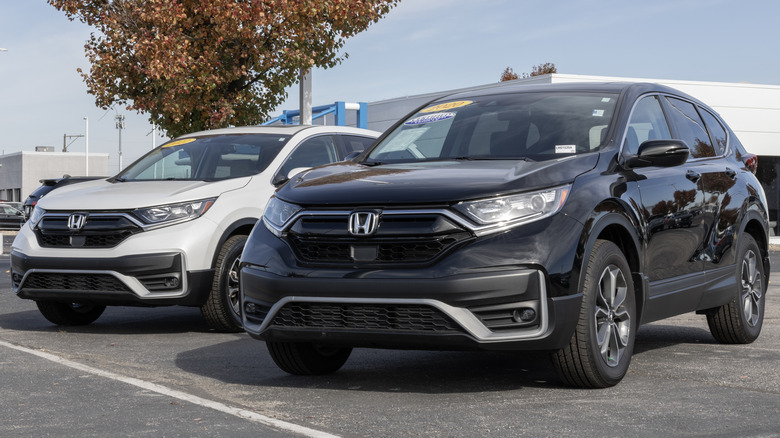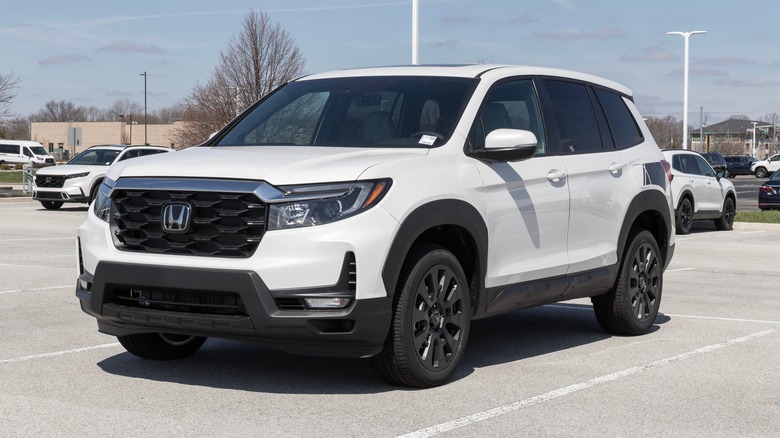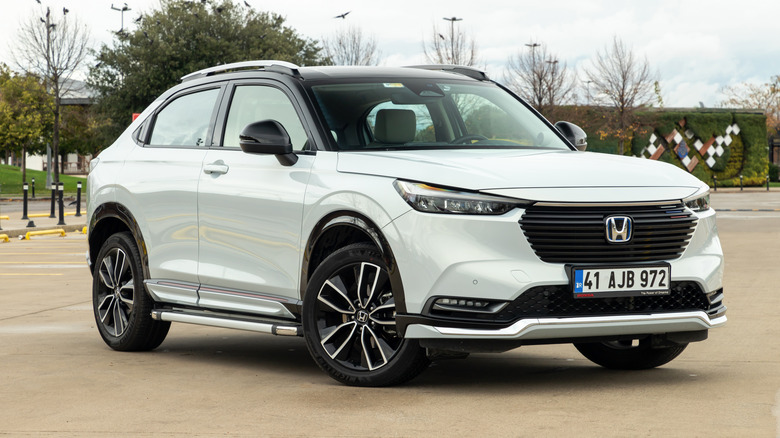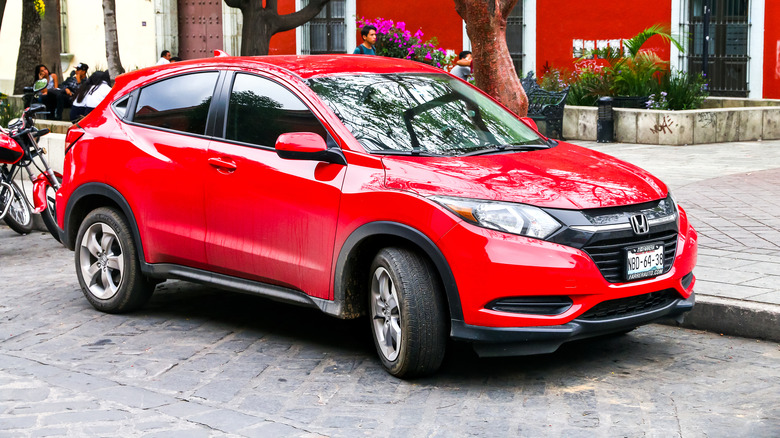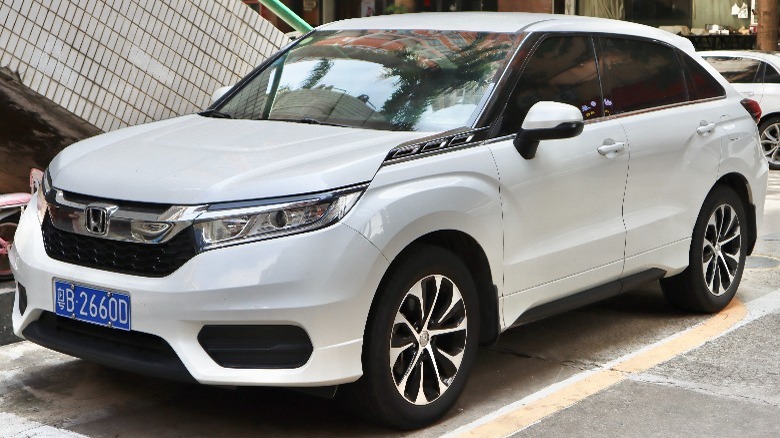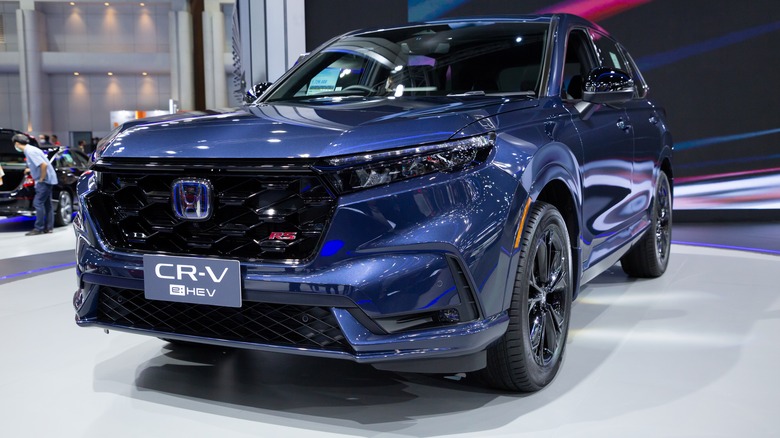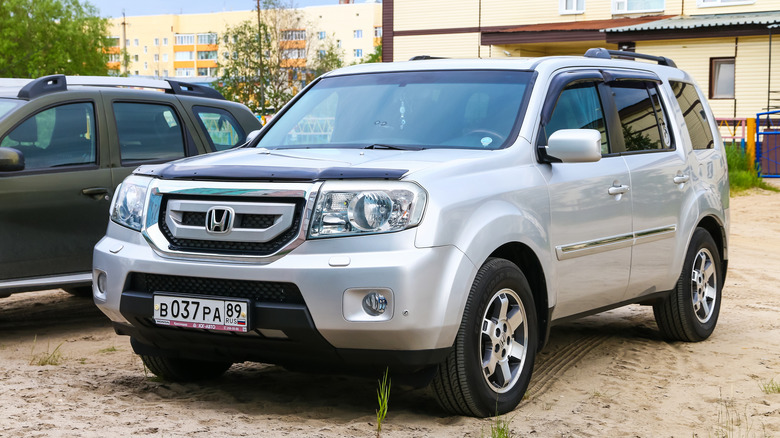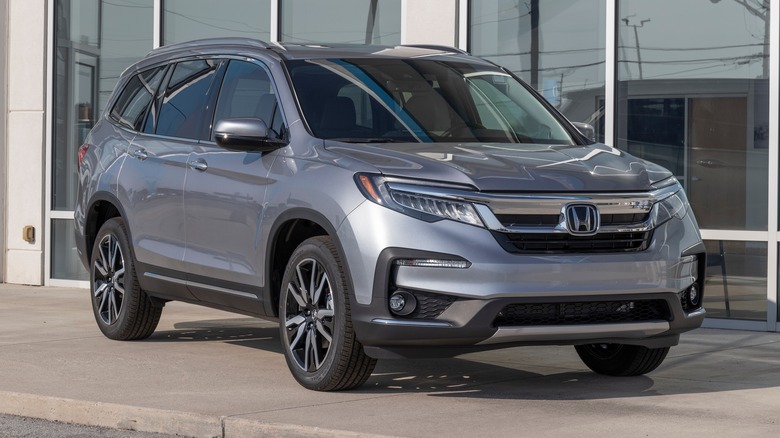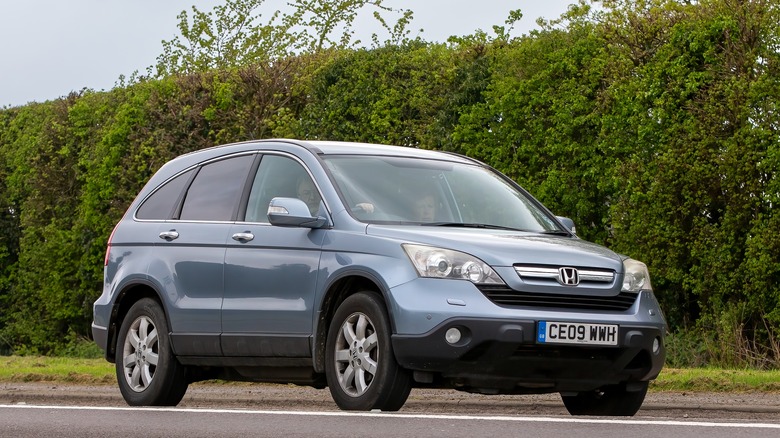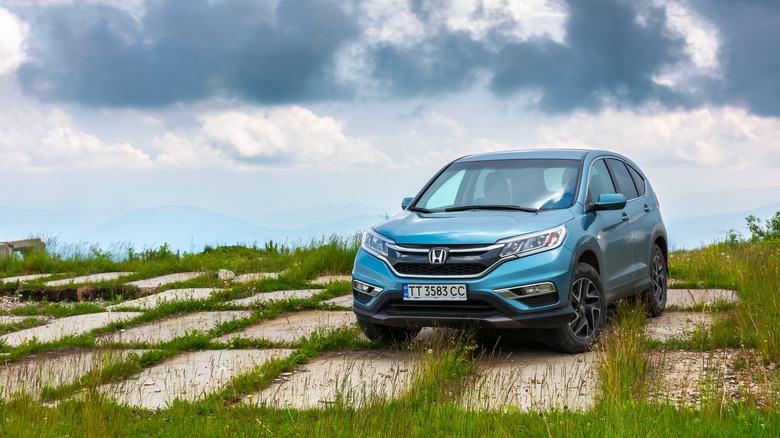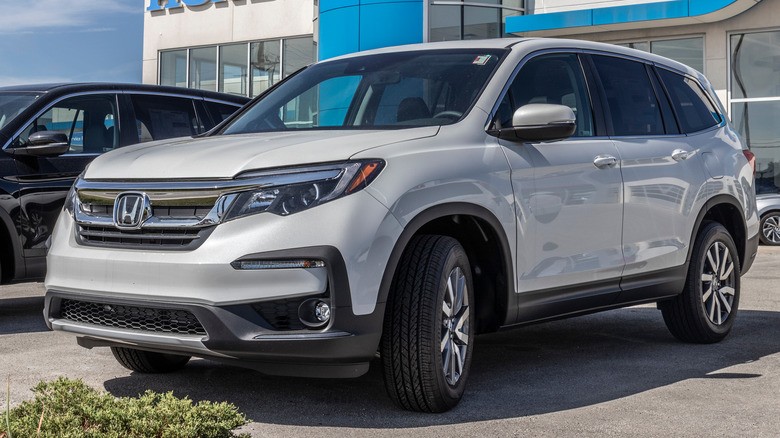Honda's 10 Top-Selling SUVs Of All Time
Honda has some of the most popular cars and SUVs in the industry. The brand is known for being fairly reliable while also making excellent use of its interior space and having fashionable cars. As of 2023, the Japanese automaker holds a 7.57% market share in the U.S. Honda is making ground as well, with strong sales in the U.S. that are bolstered quite a bit by SUVs, which Honda has in abundance.
Crossovers have been in vogue for the last decade or so as U.S. consumers migrate to them. Shoppers list the increased ride height, all-wheel drive, more cargo capacity, and more passenger capacity than the standard car as reasons why they prefer SUVs. Honda has a strong SUV lineup, including the very successful Honda CR-V along with a contingent of supporting players in the Pilot, Passport, HR-V, and the newly released Honda Prologue. The Prologue in particular is a big deal as it's Honda's first full EV SUV and goes well with the CR-V Hybrid, which has also been gaining steam in recent years, especially with the increasingly stringent U.S. emissions standards.
While the CR-V is easily the most popular SUV in Honda's lineup, it's interesting to see exactly how popular and how the rest of Honda's lineup stacks up to the flagship products. Here are Honda's top selling SUVs of all time. The SUVs are listed by generation since there are typically minimal differences between individual model years within a generation.
10. Third generation Honda Passport (2019-2024)
The third generation Honda Passport is right at the end of its production run. It's been confirmed that the 2025 Honda Passport will be entirely redesigned, marking 2024 as the final year for the current Passport generation. Thus, while the sales numbers for this generation aren't complete yet, it's close enough. The Passport is wedged between the slightly smaller Honda CR-V and the slightly larger Honda Pilot. It has more in common with the latter's 3.5-liter V6 engine versus the more fuel efficient, four-cylinder engines of the CR-V and CR-V Hybrid.
As the middle child, the Passport sells less well than its larger and smaller siblings, respectively. On average, Honda puts between 3,000 and 5,000 new Passports on the road and that's been the case since 2019. The two-row crossover's best year was 2021 where it sold 53,133 units. All told, through April 2024, Honda sold a little over 210,000 Passports from this generation. It sells about as well as its the Toyota Venza, Toyota's own two-row midsize crossover.
It's not too much of a mystery why the Passport sells less well than the Pilot and the CR-V. The CR-V, despite being smaller, is much more fuel efficient, especially if you opt for the hybrid model. Meanwhile, the Pilot is larger and adds a third row, which many folks seem to prefer. Shoppers who opted for the middle of Honda's SUV lineup were treated to a decent overall experience as reviews for the Passport are largely positive. With the redesign right around the corner, this generation of the Passport did rather well.
9. Third generation Honda HR-V (2023-present)
The Honda HR-V represents the smallest crossover in Honda's lineup. It was aggressively redesigned in 2023 to give it a more upscale-feeling interior and modern styling while keeping the athletic handling that Honda is best known for. It's still a little slow and it's not the most luxurious SUV in Honda's lineup, but the HR-V is an affordable option that starts at $25,095, which is less than many crossovers. In short, it's basically a Honda Civic on stilts.
Shoppers have responded accordingly and have already purchased over 412,000 units as of April 2024. That doesn't seem like a lot in the grand scheme of things. However, Honda tends to keep their model generations around for at least five years, which means the HR-V has plenty of time before it's put to pasture for the eventual fourth generation HR-V. So far, this generation of HR-V hasn't had any problems posting over 25,000 sales per quarter at least and often sells quite a bit more.
For now, the HR-V sits close to the bottom of the list, but it won't be there forever. The current generation HR-V averages about 32,000 sales per quarter. If you extrapolate that out for the rest of 2024, the third generation HR-V will outsell the previous generation HR-V by late 2024 or early 2025, and it shouldn't have a problem outselling the Avancier and UR-V combo before the end of its production run. So, while it sits ninth on our list for now, it will likely climb to at least seventh before the next generation comes out.
8. Second generation Honda HR-V (2015-2022)
The second-generation Honda HR-V is a unique fixture in Honda's history. The generation lasted an astounding seven years, which is way longer than most Honda cars get before a full redesign. Honda actually started building these cars in the 1990s but went on hiatus for a long time. It was reintroduced in the 2010s — with the new HR-V launching in the U.S. in 2015 — and has been around ever since. Honda didn't just leave it that way the whole time, however. It received several facelifts over its long tenure to keep up with the proverbial Joneses.
Thanks to the car's long lifespan, Honda ultimately sold a ton of HR-Vs over the years. The number ended up just a hair over 486,000. It started out rather slow with just 41,000 units moved in 2015 and reached a maximum of 99,000 units in 2019. It saw a minor dip during the COVID-19 pandemic and then Honda introduced the new HR-V during 2021. That transition — along with the semiconductor chip shortage – caused the second-generation HR-V to miss out on what would've been its best sales year.
In terms of how it operates, the HR-V is a budget vehicle through-and-through. It had above average fuel economy but a slower engine that was better for driving around town than zooming around on the highway. It also had the unique Magic Seat feature which allowed owners to fold the seat in a unique way to fit things like bicycles in the back seat without issue. It was practical, not flashy, and inexpensive. Thankfully for Honda, that's usually a pretty good recipe for success.
7. Honda Avancier / Honda UR-V (2016-2023)
The Honda Avancier and UR-V are an interesting case. They are functionally identical vehicles that were made by Honda alongside its Chinese partners for sale in China. They are based on the same platform, look very similar, and have a very similar set of features. The former is made by Guangqi Honda while the latter is made by Dongfeng Honda. Both are also powered by the same four cylinder, 1.5-liter turbo engine. Since they are so similar, we have paired them together for this list.
The two have sold rather well since their introduction in 2016 and 2017, respectively. The Avancier has done better with 387,000 units sold in total through 2022 while the UR-V brings up the rear with 206,000. Together, they have put up 593,000 in sales through 2022. Unfortunately, sales numbers aren't around for 2023 and 2024, otherwise the two might be higher on the list. However, Honda doesn't do quite as well in China as other automakers, so it's like not a huge difference either way.
Honda still sells both vehicles in China. The two vehicles received moderate refreshes for the 2024 model year. Reportedly, the two look a bit different than one another now as each Chinese partner has started branching out a bit in terms of styling. Both SUVs remain on the same architecture, though, and still have the same 1.5-liter turbo engine. Interestingly, both SUVs have optional 2.0-liter turbo engines that put out 257 horsepower, an option that Honda doesn't offer to U.S.-sold crossovers.
[Featured image by User3204 via Wikimedia Commons | Cropped and scaled | CC BY-SA 4.0]
6. Sixth generation Honda CR-V (2022-present)
Honda followed up its exceptionally popular fifth generation CR-V with a sixth generation that's been doing pretty well so far. The latest generation features a more butch and blocky appearance with an interior that matches the latest generations of the Honda Accord and the Honda Civic. Additionally, it has received new driver safety features, and the hybrid versions are officially part of the trim lineup rather than their own separate product.
The Honda CR-V has been one of the best-selling SUV in the U.S. since its introduction in 1995, and the sixth generation CR-V is carrying that tradition proudly. In just two short years, the fully redesigned CR-V has sold 717,000 units through April 2024. It should cross the one million threshold by April 2025 at the pace its currently going, which will catapult it up the list fairly significantly. The car has sold north of 90,000 units each of the last four sales quarters as of this writing and, if it hits 100,000 units in a single quarter, it'll join the fifth generation CR-V as the only SUV in Honda's lineup to boast that achievement.
It's easy to see why the CR-V is popular, as it's reasonably inexpensive compared to many of its competitors while having a good mix of comfort and athleticism. The hybrid models being available everywhere certainly helps as well as shoppers have recently been preferring hybrids over the full EVs here recently. Honda usually hits home runs with its CR-V and that hasn't changed at all with the latest generation.
5. Second generation Honda Pilot (2008-2014)
The Honda Pilot has always been a strong seller in Honda's lineup. It's the largest SUV that the Japanese automaker makes and it's a popular option in the increasing sea of three-row SUVs. The second generation model is among the oldest set of SUVs on the list as Honda made the vehicles from the 2008 model year through 2014. The squared off, boxy exterior is easily recognizable on the road and with its reliability, it's not uncommon to still a few driving around.
In terms of sales, the second-generation Pilot made a good stablemate to the more popular Honda CR-V. It sold a grand total of just under 750,000 units, making it one of Honda's most successful SUVs. It started a bit slower in its first two model years before ramping up big time, with 2013 being its peak year when 126,000 units were sold. It's a mark that the Pilot has only topped five times over the span of the next 11 years across the other generations. In short, it sold perfectly well and lived long enough to sell enough units to make this list.
However, the second-generation Pilot didn't review terribly well. It was known for being a big, heavy feeling SUV with a spartan interior space. Still, it made up for it in two important ways. The first is that it was one of the few three-row crossovers with a third row that was capable of fitting adults. It was also one of the more comfortable rides in the class, which made it good for families. Those two things — plus the fact that it cost less than its competitors such as the Nissan Murano – made it a good choice for buyers.
4. Third generation Honda Pilot (2015-2022)
The third-generation Honda Pilot picked things up right where the second generation left off. With a more fluid design, better quality interior, and versatile storage, the third-generation Pilot was everything its predecessor wasn't while still being among the best vehicles in its segment. Honda produced this version of the Pilot from 2015 through the 2022 model year, which is longer than average lifespan for Honda models. It seems Honda tends to keep models around longer when people like them.
Overall, the third-generation Honda Pilot had approximately 902,000 models sold across its lifespan. Its best year was 2018 when it moved 159,000 units, which is the most any Honda Pilot has sold dating back to 2005, which is as far back as most Honda sales records date. Its consistent success paired with its seven-year lifespan puts this version of the Pilot among the elite in terms of Honda sales. In fact, if Honda kept this model around just one more year longer, there is a chance that it would've hit the one million mark, which is something not a lot of Honda SUVs can boast.
So, where did Honda go right with this generation? It shared the ride comfort and reliable V6 with its predecessor along with the perfectly usable third row. However, it shored up the spartan interior with something much fancier and more comfortable while also upgrading the technology and safety features. It was one of the most expensive vehicles in its segment when fully loaded but it actually felt like you were getting something upscale. There was very little wrong with the third-generation Pilot.
3. Third generation Honda CR-V (2006-2010)
The list ends with a trio of Honda CR-V generations, starting with the third-generation Honda CR-V. This model existed from 2006 through the 2010 model year and really started establishing Honda's dominance in the crossover segment. Not only did the model sell exceptionally well but it was generally a very reliable and attractive vehicle for its era. You may even see the occasional old CR-V still puttering around.
It's no secret that Honda CR-Vs pile up the sales numbers. From 2006 through 2010, the approximately 981,000 third-generation Honda CR-Vs were purchased by customers. That's not too much more than the third-generation Honda Pilot, but the CR-V did it in two fewer years. In fact, the third-generation CR-V sold more vehicles per year than any version of the Honda Pilot ever sold in a single year, with 2007 standing out as the best year for this generation of the CR-V with 218,000 units sold.
The CR-V was successful for plenty of reasons. For starters, it was accessible. The base trim went for $21,545 and it maxed out at $29,745 when fully loaded. In addition, the crossover had excellent cargo space, safety ratings, and a comfortable interior. It also rode nicely and got reasonably good gas mileage for its era. Sure, it wasn't the most luxurious crossover on the road, but Honda kept it right with good prices, good quality, and good performance. Customers responded by buying a bucketload of them.
2. Fourth generation Honda CR-V (2011-2015)
The fourth generation of the Honda CR-V picked up right where its predecessor left off. Honda updated the styling to be more in line with what people were into at the time. It also added a bunch of vivid color options ranging from a metallic teal color and even a coffee brown. It seemed to be what people were into at the time because consumers gobbled this thing up like Thanksgiving dinner. It also started catching the attention of car blogs and reviewers, who routinely praised the fourth generation CR-V.
Honda hit some milestones with the fourth-generation CR-V. It was the first CR-V to top one million in total sales with approximately 1.486 million in total sales. It was also the first CR-V to sell more than 300,000 units in a single year, a milestone it reached in four of five years that this generation was available. By the time this generation of the CR-V left the metaphorical store shelves, it had solidly placed Honda at the forefront of the crossover segment. In its final year, the CR-V was the only crossover SUV in the top ten highest selling cars of 2015.
In terms of features and drivability, the fourth generation CR-V didn't rewrite the rule book. Reviewers praised the car for its athleticism while remaining mostly comfortable to drive. Honda also did a good job upgrading various safety features, keeping the technology up to date, and keeping the massive cargo space for which the CR-V is known. In short, it did everything the third generation did, but better.
1. Fifth generation Honda CR-V (2016-2021)
Honda's mantra of iteration and improvement rolled right into the fifth generation of the Honda CR-V with impressive results. This generation is, to date, the most popular version of the CR-V in Honda's history and it'll be a tough task for the sixth generation to beat it. Honda perfected its formula by keeping the CR-V competitive in all the right areas. The styling and interior were again updated to what was popular at the time while keeping all of its advantages from prior generations.
This generation of the CR-V sold a ton of units. It's the only CR-V generation to sell over two million units with a total of 2.193 million units moved across its six-year lifespan. At no point did this vehicle ever sell less than 300,000 units per year and nearly crossed the 400,000 mark in 2019 with 384,000 units sold. It did have an extra year to generate sales than the prior two generations but it hardly mattered. Even if the generation only lived five years like its predecessors, it still would've sold approximately 400,000 more units than the prior generation.
The fifth-generation Honda CR-V was a culmination in Honda's vision to deliver on what it had been working on for a decade. The cargo space was cavernous, the fuel economy kept improving, and the interior was as upscale and tech-forward as it had ever been while retaining the excellent balance of comfort and performance. It was a car with few outward flaws aside from a finicky touchscreen and the inability to tow anything of substantial weight. Thankfully, dedicated CR-V fans didn't seem to mind.
